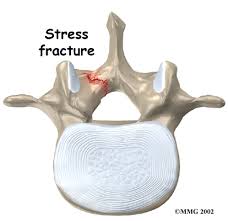Stress Fracture of the Lumbar Spine
Bone is a metabolically active tissue that undergoes continuous resorption and renewal. Stress on the bone accelerates this process. When the process of renewal is not able to keep up with the process of bone resorption a stress fracture can form.
Bone is a metabolically active tissue that undergoes continuous resorption and renewal. Stress on the bone accelerates this process. When the process of renewal is not able to keep up with the process of bone resorption a stress fracture can form.
There are 2 types of stress fractures:
A fatigue fracture occurs when abnormal stress is applied to normal bone. This is common in athletes. An insufficiency fracture occurs when normal stress is applied to bone with diminished elastic resistance.
The usual one seen in the lumbar spine is a fatigue fracture. It occurs in the area of the vertebrae called the pars interarticularis and is generally related to hyperextension, rotation and compression. It is most common on one side of the body but can occur on both sides. It is common in sports people and is seen frequently in cricket fast bowlers, throwing athletes, weightlifters, soccer players, gymnasts, dancers and Australian Rules footballers.
It is essential that it is diagnosed early as these do not always heal completely (especially those on both sides) and can lead to a permanent defect in the bone and potential for longer term low back problems.
Risk Factors
Training Volume and Insufficient Rest – Overtraining is common. Too much or the wrong type of training or sudden increases in activity and insufficient rest can overwhelm the repair process eventually leading to bone injury.
Hormonal – Overtraining or low body weight has the potential to cause lowering of oestrogen and subsequently lower bone density, or a negative calcium balance.
Other endocrine factors that have the potential to influence bone health and therefore stress fracture risk are glucocorticoids, growth hormone and thyroxin.
Nutritional Factors – Either secondary to abnormal eating behaviours or poor diet can increase the risk of stress fractures and need to be addressed in management.
Calcium balance can be affected by other dietary factors such as a high intake of salt, phosphorus, fibre, protein, caffeine and alcohol. It is not clear whether dietary supplementation with calcium or inadequate calcium in the diet is a factor in stress fractures but it is clear that restrictive or abnormal eating behaviours are a risk. Other nutrients such as potassium, iron, zinc magnesium and various vitamins are probably necessary.
Psychological Issues can result in overtraining or an eating disorder.
Muscle Fatigue – Muscles exert a protective effect on bone and muscle fatigue has been associated with increased bone fatigue.
Type of activity – certain activities especially those involving rotation, hyperextension or compression are more prone to this problem
Technique – the body position adopted in several sporting activities can lead to stress fractures. This can often be modified without detriment to performance.

